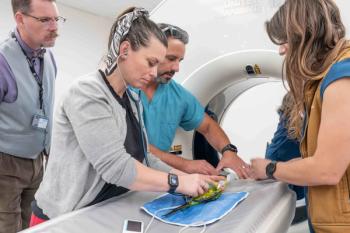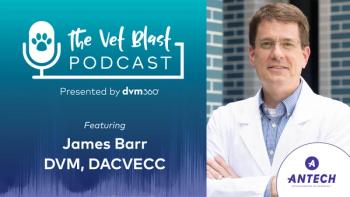
Interventional radiology in veterinary care
East Lansing, Mich. - The introduction of minimally invasive procedures such as interventional radiology offers the same benefits to animals that similar procedures have made possible in human medicine, according to one practitioner.
East Lansing, Mich. — The introduction of minimally invasive procedures such as interventional radiology offers the same benefits to animals that similar procedures have made possible in human medicine, according to one practitioner.
"As people experience less invasive procedures for their own health care and that of their family members, it evolved that their pets should experience the same advantages," says Matthew W. Beal, DVM, Dipl. ACVECC (American College of Veterinary Emergency and Critical Care).
Beal is director of Emergency and Critical Care Medicine and director of Interventional Radiology Services at Michigan State University's College of Veterinary Medicine at East Lansing.
Interventional radiology (IR) uses contemporary imaging techniques such as fluoroscopy, endoscopy, ultrasound, computed tomography (CT) and magnetic resonance imaging (MRI) to access different areas and structures of the body for therapeutic treatment.
In these approaches, standard surgical instruments are replaced by a wide variety of specially adapted devices, including guide wires, catheters, stents, balloons, coils and occlusion devices.
As a subspecialty of radiology, IR has been a part of human medical care for more than 20 years, but this approach has been applied only recently to veterinary patients.
Smaller incisions, less pain, decreased time under anesthesia and a shorter length of stay in the hospital are some of the benefits that interventional radiology procedures may offer veterinary patients over traditional surgical procedures.
Interventional radiology procedures
According to Beal, the IR approach can be adapted to many situations and can offer the benefits of surgical intervention to patients for whom surgery may not necessarily be a good option. Among the procedures available, three of the most common involve treatments for tracheal collapse, portosystemic shunt and management of nutritional support.
Tracheal collapse
Tracheal collapse is a condition primarily of middle-aged small and toy-breed dogs where progressive degeneration of the cartilage rings leads to flattening and collapse of the trachea. When medical management of cough, gagging and respiratory symptoms has been unsuccessful, surgery to place supporting prosthetic rings around the trachea has been the traditional treatment of choice.
However, this procedure can result in complications, such as disruption of the tracheal blood supply, as well as laryngeal nerve damage and subsequent laryngeal paralysis. In addition, prosthetic ring placement generally is carried out only when the collapse is in the cervical region.
An IR alternative to open surgery involves placement of an intraluminal stent into the collapsed area of the trachea. Under fluoroscopic guidance, the stent is placed via an endotracheal tube and deployed into the trachea. The outward radial force of the stent holds the trachea in a more open position.
Intraluminal stent placement also offers an effective treatment option to those dogs suffering from intrathoracic collapse where external tracheal support rings cannot be used. In most cases, the stenting procedure usually takes less than an hour to perform, is essentially pain-free and requires only 24 hours of post-operative hospital care.
Intrahepatic portosystemic shunt
With portosystemic shunts, an abnormal communication exists between the portal vein and the systemic circulation (usually the vena cava) which bypasses the liver, resulting in severe liver dysfunction. When the shunt exists outside the liver, as is the usual case with smaller breeds of dog, surgical repair can be an excellent option. But in larger breeds, the shunt is usually intrahepatic. Surgical repair of these cases is not only very difficult but carries a mortality rate of 7 percent to 70 percent.
Using an IR technique popularized at the University of Pennsylvania by Chick Weisse, VMD, Dipl. ACVS, repair of the shunt can be performed intravascularly through intravenous access in the jugular vein. This technique, called percutaneous transjugular coil embolization, is performed under fluoroscopic guidance.
After details of the shunt anatomy are identified using helical CT portography, the shunt is partially occluded using embolic coils. A stent placed in the vena cava prevents migration of the coil into the systemic circulation. By creating a favorable pressure gradient between the shunt and the vena cava, hepatic blood flow via the portal vein should increase. The increased blood flow stimulates liver growth, decreasing related symptoms for the patient.
This procedure takes approximately 90 minutes to perform but, more importantly, the morbidity and mortality rates are very low.
"Many surgeons were reluctant to perform open surgical repair of intrahepatic portosystemic shunts due to the high morbidity and mortality rates. But the veterinary community has recognized that this new procedure is valuable," Beal says. "It used to be that two or three of these procedures were performed in a year, but we have four scheduled in the coming month."
Nutrition support and more
The advantages of enteral nutritional support over parenteral nutritional support are widely recognized. In humans requiring nutritional support, enteral feeding is not only more natural but tends to be associated with fewer infective complications and shorter hospitalizations, leading to overall decreased costs of service.
In veterinary medicine, the cost savings of enteral nutritional support over parenteral methods like TPN is obvious. However, when there is poor tolerance of gastric feeds, reduced or poor motility or regurgitation and vomiting, IR offers an option for distal tube placement to support feeding directly into the jejunum.
Using fluoroscopic guidance, a catheter and guidewire are used to move past the pyloris and through the duodenum into the jejunum, where the tube is then passed.
Beal reports that jejunal access is achieved in 84 percent of patients and that nasojejunal tube placement has become the standard of care in his service where jejunal feeding is desirable, including those animals suffering from pancreatitis, septic peritonitis or any conditions associated with protracted vomiting or problems with gastric motility.
The value of IR, Beal tells DVM Newsmagazine, is that the approaches can lend themselves to a wide variety of treatments across many disciplines. In addition to relieving obstructions, aiding in placement of tubes and devices and even tracheobronchial or vascular foreign-body retrieval, IR can be used to deliver treatments more efficiently over a prolonged period.
Thrombolytic drugs and chemotherapy agents can be administered directly to the area in need, and biopsies and other tissue samplings can be accomplished more rapidly and with less trauma to the patient.
Cautions
Although IR procedures are less invasive, they do carry a level of risk. Because most procedures involve imaging technologies, exposure to radiation for the animal and the staff must be carefully monitored. Protective precautions should be taken and every effort made to limit the dose the patient receives.
Second, Dr. Beal notes that IR procedures are technically demanding and should be performed only by properly trained practitioners. In untrained or inexperienced hands, significant harm or even death may result.
The Interventional Radiology Services at Michigan State and the original IR training program at the School of Veterinary Medicine at the University of Pennsylvania in Philadelphia currently are the only two formal clinical programs that exist for this emerging specialty.
The huge commitment in costs of imaging equipment and supplies may be a contributing factor to the limited number of programs at this time.
"But, as students are coming through the professional curriculum, the more they see and the more they know what's available for their patients in the future," Beal says.
Looking ahead
Beal says he sees much enthusiasm for this specialty, not just as an offshoot of the human applications, but as its own distinct entity.
"Dogs and cats are not people," he says. "It's not just a question of adapting human procedures to animals. It's how to optimally develop techniques to meet the needs of dogs, cats and other animals in general.
"In an ideal world, it would be a true cooperative approach," Beal adds. "Maybe what we (veterinarians) discover can have broader applications. Maybe physicians could look at the techniques and results of trials that are being performed on animals and adapt them for human use. Then, everyone wins."
Wetzel is a freelance writer in Cleveland, Ohio
Disclosure: Beal is on the advisory board for Infiniti Medical, a distributor of IR products for veterinary medicine.
Newsletter
From exam room tips to practice management insights, get trusted veterinary news delivered straight to your inbox—subscribe to dvm360.






